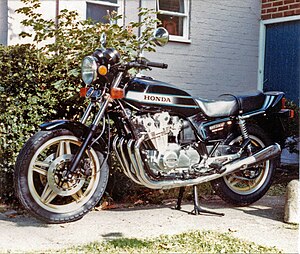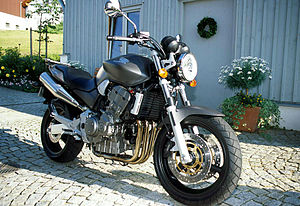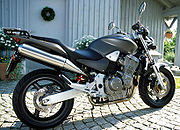The Honda CB900F is a Honda motorcycle made in two iterations which appeared some twenty years apart. Both generations of the CB900F are straight four-cylinder four-stroke 900 cc (55 cu in) roadsters.
The first generation was produced from 1979 through 1983, and was available in the United States in 1981 and 1982. In 1983 it was replaced by the CB1100F. The second generation was available from 2002 through 2007. It is called the Hornet 900 in Europe and the 919 in North America, while the related CB600F is the Hornet 600 in Europe and the 599 in North America. In 2008 the second generation CB900 was replaced by the CB1000R.
First generation
Type of motorcycle | |
| Manufacturer | Honda |
|---|---|
| Production | 1979–1983 |
| Successor | CB1100F |
| Engine | Air-cooled four-stroke 901 cc (55.0 cu in) DOHC straight-four |
| Bore / stroke | 64.5 mm × 69.0 mm (2.54 in × 2.72 in) |
| Compression ratio | 8.8:1 |
| Top speed | 190 km/h (120 mph) (1979–1981), 210 km/h (130 mph) (1982) 217 km/h (135 mph) |
| Power | 71 kW (95 hp) at 9,000 rpm |
| Torque | 7.9 kgf⋅m (77 N⋅m; 57 lbf⋅ft) |
| Ignition type | Electric start |
| Transmission | Wet, multi-plate clutch, 5-speed manual, chain final drive |
| Frame type | Steel twin downtube |
| Suspension | Front: Air-assisted telescopic forks 160 mm (6.4 in) travel, Honda TRAC anti-dive fork from 1982/83 Rear: twin shocks 110 mm (4.3 in) travel, adj. compression, damping, rebound |
| Brakes | Front: 2 × 270 mm (10.7 in) disc Rear: 290 mm (11.5 in) disc Dual piston calipers on all after 1983 |
| Tires | Bridgestone Mag Mopus. Front: 3.25"×19" (100/90-19) Rear:4"×18" (130/80-18) |
| Rake, trail | 27.5°, 115 mm (4.5 in) |
| Wheelbase | 1,515 mm (59.6 in) |
| Dimensions | L: 2,240 mm (88 in) W: 805 mm (31.7 in) |
| Seat height | 815 mm (32.1 in) |
| Weight | 233 kg (514 lb) 241 kg (531 lb) (after 1982), or 234 kilograms (516 lb) (dry) 258 kg (568 lb) (1/2 fuel) (wet) |
| Fuel capacity | 20 L (4.4 imp gal; 5.3 US gal) |
| Fuel consumption | 5.0 L/100 km; 56 mpg‑imp (47 mpg‑US) |
| Related | CB750, CB900C |
Background
In 1969 Honda introduced its flagship CB750 superbike, whose success led to Honda's domination of the motorcycle market. Honda had been successful in European endurance racing with their RCB-series RS1000, and had made advances in suspension technology from their experience in motocross, and the company chose to base a new DOHC roadster on their endurance racer.
The CB900F's design was aimed at European markets, rather than the usual focus on the United States, where it was not available until 1981. In Europe, it was initially named Super Sport like the 750 (FZ and FA) later named after the Bol d'Or endurance race. In the market, the CB900F competed with larger capacity bikes like the Kawasaki Kz1000, Suzuki GS1000, and Yamaha XS1100.
Design
The CB900F's engine has a 901 cc (55.0 cu in) four-cylinder DOHC engine with a bore and stroke of 64.5 by 69.0 mm (2.54 by 2.72 in). The engine drew on other designs, such as the CB1000C, CB1100F/CB1100R, and the inline-6 CBX1000. The CB900F has a five-speed gearbox and chain final drive, and it produces 71 kW (95 bhp) at 9,000 rpm The CB900F has two front disc brakes and one rear disk brake, all fitted with dual-piston calipers after 1983. The air-assisted fork was fitted with the Honda TRAC (torque reactive anti-dive control) anti-dive system in 1982 or 1983. The bike shares the same bodywork (tank, side covers, tailpiece) as the earlier CB750F Super Sport. There are similarities between the CB900F bodywork and that of the CB1100F and CBX.
Performance
In magazine tests, the CB900F typically clocked low to mid 12 seconds in the quarter mile (and a low 11.84 seconds in a Motorcyclist magazine test). The engine was tuned to produce mid range power rather than maximizing peak horsepower, thus giving good acceleration from 4,000 rpm to the 9,500 rpm redline. At 140 km/h (90 mph) there was some vibration, but the relaxed riding position was comfortable at most speeds, but at the 210 km/h (130 mph) maximum speed wind pressure could cause rider discomfort. The CB900F was succeeded in 1983 by the CB1100F, and in 1987 Honda introduced the CBR1000F water-cooled inline fours.
Reception
Honda's advertising proclaimed the bike to be "a thundering Super-Sports bike with devastating performance and an unwavering stamina". The bike's conventional twin down-tube steel frame is very strong. This, along with improved suspension made the CB900F "arguably the best Honda had built for the street," and capable of challenging European motorcycles in performance and roadholding. For its time, the CB900F was called, "the ultimate statement of the old air-cooled technology Honda had done so much to create". In anticipation of the 2002 model, one reporter reminisced that the original "was a powerful machine, if a bit heavy. All gas tank and engine, stable on the highway, middle-of-the-road good looks and hound-dog reliable." Rod Ker, however, writes that it had "two bad habits," that "it dropped out of gear, and — sometimes as a direct result — broke con-rods. This was a great pity, because it was a good bike until it broke, blessed with a frame and suspension that showed the Japanese were catching up with the Europeans in chassis technology."
Second generation
Type of motorcycle | |
| Manufacturer | Honda |
|---|---|
| Also called | Honda Hornet 900 (Europe) Honda 919 (United States) |
| Production | 2002–2007 |
| Successor | CB1000R |
| Class | Standard |
| Engine | 919 cc (56.1 cu in) liquid-cooled straight four |
| Bore / stroke | 71.0 mm × 58.0 mm (2.80 in × 2.28 in) |
| Compression ratio | 10.8:1 |
| Top speed | 230.0 km/h (142.9 mph) 228.5 km/h (142.0 mph) |
| Power | 71.9 kW (96.4 hp) 75 kW (101 hp) at 8,550 rpm 77 kW (103 hp), 80 kW (110 hp) at 9,000 rpm |
| Torque | 84.9 N⋅m (62.6 lbf⋅ft) 91 N⋅m (67 lbf⋅ft) at 6,500 rpm 88.9 N⋅m (65.6 lbf⋅ft) at 7,550 rpm |
| Ignition type | CDI |
| Transmission | Cable-actuated wet clutch, 6 speed, chain final drive |
| Frame type | Steel, square section backbone, engine is stressed member |
| Suspension | Front: telescoping cartridge fork, adjustable after 2004 Rear: swingarm with single Showa shock, adjustable preload |
| Brakes | Front: dual disc Rear: single disc |
| Tires | Michelin Hi-Sport Front: 120/70-ZR17 Rear:180/55-ZR17 |
| Rake, trail | 25°, 98 mm (3.9 in) |
| Wheelbase | 1,460 mm (57 in) |
| Dimensions | L: 2,125 mm (83.7 in) W: 750 mm (30 in) |
| Seat height | 795 mm (31.3 in) |
| Weight | 206.0 kg (454.2 lb) (dry) 218.0 kg (480.6 lb), 220.0 kg (485.0 lb) (wet) |
| Fuel capacity | 19 L (4.2 imp gal; 5.0 US gal) |
| Fuel consumption | 6.11 L/100 km (46.2 mpg‑imp; 38.5 mpg‑US) 6.4 L/100 km (44 mpg‑imp; 37 mpg‑US) |
| Related | CB600F CBR900RR |
The second generation Honda CB900F is a standard motorcycle based on a sport bike engine but with a more upright seating position and revised engine and gearing, providing performance and comfort between a typical sport bike and a cruiser. It was called the Hornet in Europe and the 919 in North America because the trademark for the vehicle name Hornet in North America was held by Chrysler, acquired after buying AMC, maker of the AMC Hornet car.
In some ways the concept dates to a 1994 design study created by American Honda's R&D chief product evaluator Dirk Vandenberg in cooperation with Cycle World magazine, a streetfighter-like one-off custom based on the Honda CBR900RR, with the fairings removed, high, tubular handlebar, and tuning and gearing modified to boost low-end torque. Vandenberg saw a market in the "older sportbike crowd" who are seeking high performance without an awkward riding position or racetrack style bodywork.
It was introduced in 2002 and its last model year was 2007, after which it was replaced by the CB1000R. After compliance with tightening emissions regulations became untenable, it was replaced by the more performance-specialized CB1000R. In 2006, Motorcyclist recommended used 919s as a good buy, saying of the new bike, "at $7999, it wasn't exactly cheap, and saddled with a coat of flat-black paint called Asphalt, it was less than visually electrifying," however, in the used market it became a great value. In the US market, the 919, like the 599, was expensive, because, being intended for the European market, they were made in Italy, and so had to be imported to the US against unfavorable Euro exchange rates.
The Daily Telegraph welcomed the new bike, saying, "the new CB900F Hornet leaves your knees in the breeze and your smile full of bugs as it reintroduces you to a feeling of undemanding, rewarding two-wheeled fun that has been missing from the market for a long time." Comparing it to the Hornet 600, the bike was reminiscent of the standards of the 1970s, sometimes called Universal Japanese Motorcycles.

 UK-spec Hornet
UK-spec Hornet
Design
The CB900F is powered by a de-tuned Honda CBR900RR engine, developed by Tadao Baba, one of Honda's Large Project Leaders. The motor is a transversely mounted, liquid-cooled, fuel-injected 919 cc (56.1 cu in) in-line four-stroke, four-cylinder DOHC engine that produces around 100 hp (75 kW). The engine has cast camshafts and pistons instead of the more expensive forged versions found on the CBR929 and later. For greater midrange torque, the CB900F's camshaft lift is lower, and compression is slightly lowered. Four 36 mm (1.4 in) fuel-injection throttle bodies take the place of the CBR900RR's 38 mm (1.5 in) carburetors. Redline is 9500 rpm. The bike has a cable-actuated clutch, a six-speed transmission, and a chain final drive.
A steel, square-tube backbone frame supports the stressed member engine. In front, a cartridge fork (adjustable beginning in 2004) guides the wheel, while a single Showa shock, adjustable only for preload (and rebound damping beginning in 2004) connects with the aluminum swingarm and carries the weight in back. Its brakes are dual-disc in the front and single-disc in the rear.
Instrumentation consists of an analog speedometer and tachometer and basic indicator lamps, incorporated under a tinted window, and a single tripmeter. While it normally was equipped with a centerstand, California models did not have room for one due to additional emissions control equipment.
The rake is 25°, trail is 98 mm (3.9 in), wheelbase is 1,460 mm (57 in), and seat height is 800 mm (31 in). It has a tested dry weight (minus fuel only) of 206 kg (455 lb) and a tested wet weight of 220 kg (485 lb). The chain drive is a 530 chain with stock gearing of 16 tooth front and 43 tooth rear sprockets.
A 599 cc (36.6 cu in) carburetted version exists in the form of the CB600F, known as the Hornet 600 in Europe and the 599 in North America.
Performance
Quarter-mile performance for the second generation bike was 11.18 seconds at 194.2 km/h (120.7 mph) tested by Motorcyclist, while Cycle World measured 10.92 seconds at 198 km/h (123 mph). Having the lowest weight in its class and a good power-to-weight ratio, it stands well in comparison to bikes with greater output like the Yamaha FZ1, and the wide, high handlebars ease quick turning and make cornering enjoyable. The suspension of the early versions was criticized, but after the upgrade to an adjustable fork, the complaints died down. Cycle World saw the 919 as a practical solution to the real-world problem of imperfect roads and traffic, rather than a mere compromise between a sportbike and a commuter or touring ride.
See also
Notes
- ^ Myers, Chris (1984), Honda, New York City: Arco, pp. 41–42, ISBN 0-668-06173-1
- ^ Ash, Kevin (3 November 2001), "Here's one to give you a buzz FIRST RIDE It might not have the raw appeal of the FireBlade, but Honda's Hornet 900 is an excellent all-rounder, says Kevin Ash", The Daily Telegraph, London (UK), p. 12
- ^ Ash, Kevin (29 September 2001), "Japan steals the show On Two Wheels Motorcycle fashionistas were treated to a parade of supermodels in Milan as manufacturers unveiled their latest machines or gave old ones a new twist.", The Daily Telegraph, London (UK), p. 12
- ^ Newbigging, Chris (6 November 2007), Milan Show: FireBlade-based Honda CB1000R to replace Honda Hornet 900, retrieved 2010-02-09
- ^ Europe Intelligence Wire (August 15, 2008), Check out Honda's new naked cb1000r, Financial Times Ltd.
- Rafferty, Tod (1997), Complete Harley Davidson: A Model-by-Model History of the American Motorcycle, Crestline Imprints, p. 121, ISBN 0-7603-0326-6
- ^ Brown, Roland (2005), The ultimate history of fast motorcycles, Bath, England: Parragon, pp. 158–159, ISBN 1-4054-5466-0
- Walker, Mick (2006), Motorcycle: Evolution, Design, Passion, JHU Press, p. 152, ISBN 0-8018-8530-2
- ^ Ker, Rod (2007), Classic Japanese Motorcycle Guide, Sparkford, UK: Haynes Publishing, ISBN 978-1-84425-335-7
- ^ Ayton, C. J. (1981), The Great Japanese Motorcycles, New York City: Galahad Books, p. 168, ISBN 0-88365-552-7
- ^ "Honda CB900F; Honda Hot Rod Is Here At Last", Cycle World, pp. 62–73, May 1981
- "The Dawn of the Superbike: Honda's Remarkable CB750", AMA Motorcycle Hall of Fame, American Motorcyclist Association, archived from the original on 2010-01-13, retrieved 2010-02-20
- Walker, Mick (2006), Motorcycle: Evolution, Design, Passion, JHU Press, p. 150, ISBN 0-8018-8530-2
- ^ Cameron, Kevin (2007), "Soichiro's Ladder; Twenty-five years of technical progress (September 1985)", Top dead center : the best of Kevin Cameron from Cycle world magazine, Saint Paul, Minnesota: Motorbooks, pp. 203–211, ISBN 978-0-7603-2727-2
- Margie Siegal (November–December 2010). "1981 Honda CB900F; Old school cool". Motorcycle Classics. Retrieved October 26, 2010.
- Motorcyclist, April 1981
{{citation}}: Missing or empty|title=(help) - "Honda CB900F is guaranteed to make you smile", Toronto Sun, Autonet.ca, 11 March 2002, archived from the original on 15 January 2013, retrieved 2010-02-08
- ^ "Winter '09/'10 Edition" (PDF), Motorcycle Consumer News, archived from the original (Adobe PDF) on 2010-02-15, retrieved 2010-02-08
- ^ Cernicky, Matt (August 2002), "Honda 919; Yellow Peril Revisited", Cycle World, pp. 46–48
- ^ "2002-2006 Honda 919.(SMART MONEY)", Motorcyclist, no. 1314, Primedia Enterprises, p. 94, September 2006
- ^ "Sport Bike Motorcycle Weight, Horsepower, Torque and Fuel Economy - Dimensions - Sport Rider". Archived from the original on 2009-06-18. Retrieved 2010-02-03.
- ^ Freund, Ken (May 2002), "Fraternal twins: The 2002 Honda 919 and CBR954RR.(evaluation)", Rider, vol. 29, no. 5, p. 28
- Richardson, Mark (10 August 2002), "Catch the buzz, pop a wheelie, turn 40, don't look back ; Time to grow up? Therapy or bikes? Questions, questions;", Toronto Star, Toronto, Ontario, p. G.21
- Miles, Matthew (April 1994), "Yellow Peril; Project CBR900RR: A cure for the substandard standard", Cycle World, pp. 46–49
- Hoyer, Mark (October 2009), "Forbidden Fun: CBR1000R: The best Honda you can't buy!", Cycle World, vol. 48, no. 10, pp. 30–37
- ^ Matheson, Mick (21 June 2002), "Hornet is bees' knees", Daily Telegraph, Nationwide News Proprietary, p. 94
- ^ Booth, David (4 January 2002), "Honda leads two-wheeled charge: Spring promises to be an exciting time for motorcyclists as manufacturers roll out the new and improved", National Post, Don Mills, Ontario, p. DO.8
References
- Honda CB900F/919 Service Manual. Tokyo Japan: Honda Motor Co. LTD. pp. 1–3.
- Honda CB900F/900 Specifications. Australia: Honda Australia PTY LTD.
External links
- Honda 919 - official press and photo releases
- CB900F(919) Specifications, Honda Australia
| Honda motorcycle timeline, 1970s (street) - next » | ||||||||||||||||||||||||||||||||||||||||||||||||||||||||||||||||||||||||||||||||||||||||||||||||||||||||||||||||||||||||||||||||||||||||||||||||||||||||||||||||||||||||||||||||||||||||||||||||||||||||||||||||||
|---|---|---|---|---|---|---|---|---|---|---|---|---|---|---|---|---|---|---|---|---|---|---|---|---|---|---|---|---|---|---|---|---|---|---|---|---|---|---|---|---|---|---|---|---|---|---|---|---|---|---|---|---|---|---|---|---|---|---|---|---|---|---|---|---|---|---|---|---|---|---|---|---|---|---|---|---|---|---|---|---|---|---|---|---|---|---|---|---|---|---|---|---|---|---|---|---|---|---|---|---|---|---|---|---|---|---|---|---|---|---|---|---|---|---|---|---|---|---|---|---|---|---|---|---|---|---|---|---|---|---|---|---|---|---|---|---|---|---|---|---|---|---|---|---|---|---|---|---|---|---|---|---|---|---|---|---|---|---|---|---|---|---|---|---|---|---|---|---|---|---|---|---|---|---|---|---|---|---|---|---|---|---|---|---|---|---|---|---|---|---|---|---|---|---|---|---|---|---|---|---|---|---|---|---|---|---|---|---|---|---|
| ||||||||||||||||||||||||||||||||||||||||||||||||||||||||||||||||||||||||||||||||||||||||||||||||||||||||||||||||||||||||||||||||||||||||||||||||||||||||||||||||||||||||||||||||||||||||||||||||||||||||||||||||||
| « previous - Honda motorcycle timeline, 2000–2009 - next » | |||||||||||||||||||||||||||||||||||||||||||||||||||||||||||||||||||||||||||||||||||||||||||||||||||||||||||||||||||||||||||||||||||||||||||||||||||||||||||||||||||||||||||||||||||||||||||||||||||||||||||||||||||||||||||||||||||||||||||||||||||||||||||||||||||||||||||||||||||||||||||||||||||||||||||||||||||||||||||||||||||||||||||||||||||||||||||||||||||||||||||||||||||||||||||||||||||||||||||||||||||||||||||||||||||||||||||||||||||||||||||||||||||||||||||||||||||||||||||||||||||||||
|---|---|---|---|---|---|---|---|---|---|---|---|---|---|---|---|---|---|---|---|---|---|---|---|---|---|---|---|---|---|---|---|---|---|---|---|---|---|---|---|---|---|---|---|---|---|---|---|---|---|---|---|---|---|---|---|---|---|---|---|---|---|---|---|---|---|---|---|---|---|---|---|---|---|---|---|---|---|---|---|---|---|---|---|---|---|---|---|---|---|---|---|---|---|---|---|---|---|---|---|---|---|---|---|---|---|---|---|---|---|---|---|---|---|---|---|---|---|---|---|---|---|---|---|---|---|---|---|---|---|---|---|---|---|---|---|---|---|---|---|---|---|---|---|---|---|---|---|---|---|---|---|---|---|---|---|---|---|---|---|---|---|---|---|---|---|---|---|---|---|---|---|---|---|---|---|---|---|---|---|---|---|---|---|---|---|---|---|---|---|---|---|---|---|---|---|---|---|---|---|---|---|---|---|---|---|---|---|---|---|---|---|---|---|---|---|---|---|---|---|---|---|---|---|---|---|---|---|---|---|---|---|---|---|---|---|---|---|---|---|---|---|---|---|---|---|---|---|---|---|---|---|---|---|---|---|---|---|---|---|---|---|---|---|---|---|---|---|---|---|---|---|---|---|---|---|---|---|---|---|---|---|---|---|---|---|---|---|---|---|---|---|---|---|---|---|---|---|---|---|---|---|---|---|---|---|---|---|---|---|---|---|---|---|---|---|---|---|---|---|---|---|---|---|---|---|---|---|---|---|---|---|---|---|---|---|---|---|---|---|---|---|---|---|---|---|---|---|---|---|---|---|---|---|---|---|---|---|---|---|---|---|---|---|---|---|---|---|---|---|---|---|---|---|---|---|---|---|---|---|---|---|---|---|---|---|---|---|---|---|---|---|---|---|---|---|---|---|---|---|---|---|---|---|---|---|---|---|---|---|---|---|---|---|---|---|---|---|---|---|---|---|---|---|---|---|---|---|---|---|---|---|---|---|---|---|---|---|---|---|---|---|---|---|---|---|---|---|---|---|---|---|---|---|---|---|---|---|---|---|---|---|---|---|---|---|---|---|---|---|---|---|---|---|---|---|---|---|---|---|---|---|---|---|---|---|---|---|
| |||||||||||||||||||||||||||||||||||||||||||||||||||||||||||||||||||||||||||||||||||||||||||||||||||||||||||||||||||||||||||||||||||||||||||||||||||||||||||||||||||||||||||||||||||||||||||||||||||||||||||||||||||||||||||||||||||||||||||||||||||||||||||||||||||||||||||||||||||||||||||||||||||||||||||||||||||||||||||||||||||||||||||||||||||||||||||||||||||||||||||||||||||||||||||||||||||||||||||||||||||||||||||||||||||||||||||||||||||||||||||||||||||||||||||||||||||||||||||||||||||||||